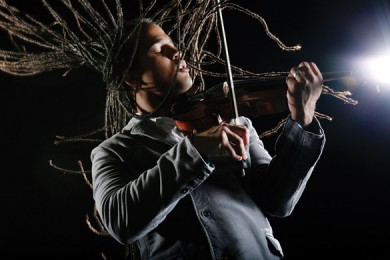New World’s preseason concert offers genre-crossing premiere

The New World Symphony gave the world premiere of Daniel Bernard Roumain's "Dancers, Dreamers and Presidents" Saturday night at the Lincoln Theatre.
Although the New World Symphony’s official opening night is still three weeks off, the ensemble held its first full orchestra concert as part of its preseason events Saturday night at Miami Beach’s Lincoln Theatre.
These are informal events that allow the orchestra to undergo a final shakeout before the regular season–an important step for an ensemble that sees an annual turnover of about a third of its members as the young musicians depart, many for jobs with professional orchestras.
Under principal guest conductor Alasdair Neale, the New World performed Beethoven’s Fifth Symphony, his Leonore Overture No. 3 and the world premiere of a work by a South Florida native who has received increasing media attention for his composing.
The orchestra played well, although the musicians are clearly still settling in. In the Leonore Overture, wind and brass playing was accurate throughout, and flutist Katrina Walter played the main theme with lively, effortless grace. At times, though, the brass were overbalanced, aggressively overpowering the other sections and drowning out the melody. The strings didn’t yet display the knife-edged precision that they have at their best in past seasons, though the lightning final section was brilliantly played.
The centerpiece of the concert was the world premiere of Dancers, Dreamers and Presidents, a three-movement work by the dreadlocked, genre-crossing composer Daniel Bernard Roumain. A native of Margate, Roumain learned to play the violin in public school and went on to study composition with William Bolcom at the University of Michigan. Drawing on Haitian, classical and popular styles, he has composed film and theater scores, seen his work performed at the Brooklyn Academy of Music, Carnegie Hall and the Kennedy Center, and even appeared with Lady Gaga on American Idol. (The work was commissioned by the Sphinx Commissioning Consortium, which supports compositions by black and Latino composers.)
As Roumain told the audience in preconcert remarks Saturday, the piece was inspired by a segment on The Ellen DeGeneres Show, in which Barack Obama, then the junior senator from Illinois, danced with the host for 21 seconds. He was struck and inspired by the sight of a mixed-race straight man dancing with a white lesbian on daytime television, with all the positive changes that implied for society.
The piece is a highly accessible, beat-driven work, built around repeated chord progressions in which the rhythmic and harmonic elements gain in complexity and intensity. The first movement, Dancers, opens with stark solo drum beats, the strings and brass joining in with rhythmic figures that treat these sections of the orchestra as percussion instruments. A jazzy melody appears and goes through repeated variations that become more harmonically rich. The movement had a grim, driving quality that didn’t sound much like the self-conscious televised dance that inspired it, but contained ample energy that carried it forward.
The other movements followed a similar progression–pop beats in percussion with repeated harmonic figures and growing dissonance, with the last movement gaining a presidential stateliness and grandeur.
Although the specific televison event that inspired Roumain was not always apparent, the work was entertaining and easy to follow, if rather lightish with each movement constituting a sort of passacaglia with a pop beat. It will have a chance to prove itself over the next year, as it is performed by the eight other orchestral member of the Sphinx Consortium.
Surprisingly, even though most of the musicians had probably played the two Beethoven works a few times before in youth and conservatory orchestras, they played with much more intensity and authority in Roumain’s work, likely because as a world premiere it claimed more rehearsal time.
The evening concluded with Beethoven’s Fifth Symphony. In the first movement, Neale took a brisk tempo and led a performance that offered more headlong energy than dramatic bite. There was some mushy ensemble work, with violins lacking an incisive edge in rapid passagework. Cellos played well throughout, in their second movement melody with the violas and in the quick third movement. Neale and the orchestra gave a dramatic and gripping account of the transition from the third to final movements, in which dark and mysterious figures in the strings give way to radiant, major-key blasts in the full orchestra.
The program repeats 3 p.m. Sunday at the Lincoln Theatre. According to the orchestra’s web site, the concert is sold out. nws.edu
Posted in Performances
Leave a Comment
Sun Sep 26, 2010
at 2:48 pm
No Comments






